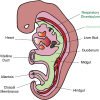Idiopathic Pulmonary Fibrosis: Novel Concepts of Proton Pump Inhibitors as Antifibrotic Drugs
- PMID: 27110898
- PMCID: PMC4910893
- DOI: 10.1164/rccm.201512-2316PP
Idiopathic Pulmonary Fibrosis: Novel Concepts of Proton Pump Inhibitors as Antifibrotic Drugs
Abstract
The prevalence of abnormal acid gastroesophageal reflux (GER) is higher in patients with idiopathic pulmonary fibrosis (IPF) than in matched control subjects. Several studies demonstrated that more than one-third of patients with IPF have abnormal esophageal acid exposures. In addition, many of these studies indicate that the majority of patients with IPF have silent reflux with no symptoms of GER. Findings of abnormal reflux persist in a large proportion of patients with IPF placed on antacid therapy such as proton pump inhibitors (PPIs). This seemingly paradoxical observation suggests that either patients with IPF are somehow resistant to PPI-based intervention or PPIs are inherently unable to suppress acid GER. By contrast, patients with IPF who undergo Nissen fundoplication surgery are effectively relieved from the complications of GER, and retrospective studies suggest improved lung function. Retrospective, anecdotal data suggest a beneficial role of PPIs in IPF including stabilization of lung function, reduction in episodes of acute exacerbation, and enhanced longevity. The recent evidence-based guidelines for treatment of IPF approved conditional recommendation of PPIs for all patients with IPF regardless of their GER status. Recently, we have reported that PPIs possess antiinflammatory and antifibrotic activities by directly suppressing proinflammatory cytokines, profibrotic proteins, and proliferation of lung fibroblasts. Our study provides an alternative explanation for the beneficial effect of PPIs in IPF. In this Perspective, we reviewed emerging progress on antifibrotic effect of PPIs using IPF as a disease model. In addition, we summarized surgical and pharmacological interventions for GER and their downstream effect on lung physiology.
Keywords: antireflux surgery; fibrosis; gastroesophageal reflux; lung inflammation; proton pump inhibitors.
Figures



Similar articles
-
Pleiotropic effect of the proton pump inhibitor esomeprazole leading to suppression of lung inflammation and fibrosis.J Transl Med. 2015 Aug 1;13:249. doi: 10.1186/s12967-015-0614-x. J Transl Med. 2015. PMID: 26231702 Free PMC article.
-
High prevalence of abnormal acid gastro-oesophageal reflux in idiopathic pulmonary fibrosis.Eur Respir J. 2006 Jan;27(1):136-42. doi: 10.1183/09031936.06.00037005. Eur Respir J. 2006. PMID: 16387946
-
Proton pump inhibitors in IPF: beyond mere suppression of gastric acidity.QJM. 2016 Sep;109(9):577-579. doi: 10.1093/qjmed/hcw115. QJM. 2016. PMID: 27647940 Free PMC article. Review.
-
Effectiveness of Proton Pump Inhibitors in Idiopathic Pulmonary Fibrosis: A Population-Based Cohort Study.Chest. 2021 Feb;159(2):673-682. doi: 10.1016/j.chest.2020.08.2080. Epub 2020 Sep 1. Chest. 2021. PMID: 32882251
-
Antacid therapy in idiopathic pulmonary fibrosis: more questions than answers?Lancet Respir Med. 2017 Jul;5(7):591-598. doi: 10.1016/S2213-2600(17)30219-9. Lancet Respir Med. 2017. PMID: 28664861 Review.
Cited by
-
Cough in Idiopathic Pulmonary Fibrosis.Front Rehabil Sci. 2021 Oct 18;2:751798. doi: 10.3389/fresc.2021.751798. eCollection 2021. Front Rehabil Sci. 2021. PMID: 36188759 Free PMC article. Review.
-
Association between Antacid Exposure and Risk of Interstitial Lung Diseases.Tuberc Respir Dis (Seoul). 2024 Apr;87(2):185-193. doi: 10.4046/trd.2023.0093. Epub 2023 Dec 19. Tuberc Respir Dis (Seoul). 2024. PMID: 38111098 Free PMC article.
-
Effect of anti-reflux therapy on pulmonary function in idiopathic pulmonary fibrosis: a systematic review and meta-analysis.J Thorac Dis. 2021 Oct;13(10):5776-5787. doi: 10.21037/jtd-21-771. J Thorac Dis. 2021. PMID: 34795926 Free PMC article.
-
Proton Pump Inhibitors in IPF: A Call for Clinical Trials.Front Pharmacol. 2018 May 17;9:499. doi: 10.3389/fphar.2018.00499. eCollection 2018. Front Pharmacol. 2018. PMID: 29867501 Free PMC article. Review.
-
Update in Interstitial Lung Disease 2016.Am J Respir Crit Care Med. 2017 Jul 15;196(2):132-138. doi: 10.1164/rccm.201702-0351UP. Am J Respir Crit Care Med. 2017. PMID: 28530124 Free PMC article. No abstract available.
References
-
- Duke University; Lung and diaphragm development. 2015 [accessed 2015 Nov 20]. Available from: https://web.duke.edu/anatomy/embryology/respiratory/lungDiaphragm.html.
-
- Tobin RW, Pope CE, II, Pellegrini CA, Emond MJ, Sillery J, Raghu G. Increased prevalence of gastroesophageal reflux in patients with idiopathic pulmonary fibrosis. Am J Respir Crit Care Med. 1998;158:1804–1808. - PubMed
-
- Raghu G, Freudenberger TD, Yang S, Curtis JR, Spada C, Hayes J, Sillery JK, Pope CE, II, Pellegrini CA. High prevalence of abnormal acid gastro-oesophageal reflux in idiopathic pulmonary fibrosis. Eur Respir J. 2006;27:136–142. - PubMed
-
- Robinson NB, DiMango E. Prevalence of gastroesophageal reflux in cystic fibrosis and implications for lung disease. Ann Am Thorac Soc. 2014;11:964–968. - PubMed
Publication types
MeSH terms
Substances
Grants and funding
LinkOut - more resources
Full Text Sources
Other Literature Sources
Molecular Biology Databases

